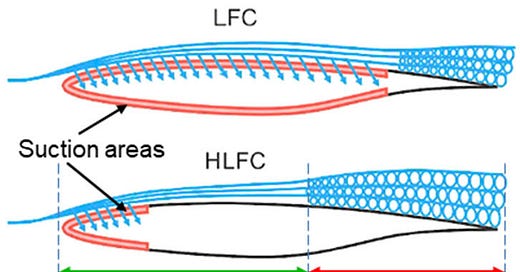Laminar Flow Cruise Missiles
Can we greatly increase the range of cruise missiles by adopting an abandoned aerodynamics technique?
TLDR:
Laminar flow control can boost airplane efficiency and range by 50%+, but is considered impractical for maintenance reasons.
These maintenance concerns aren’t relevant to cruise missiles, and thus laminar flow control can be used to create a cruise missile with much greater range and/or payload (~50%).
Key Idea:
Laminar flow control is an aerodynamic technique which can greatly increase the efficiency of aircraft by almost 50%.
This technique has never been considered practical because the holes required for laminar flow get clogged easily across multiple missions.
This creates a maintenance and reliability nightmare for transport aircraft, making it impractical.
However, cruise missiles don’t really care about this. They are only used once, and maintenance isn’t important. Reliability is also less important, since it’s okay if a few missiles have less range than expected.
For passenger airliners, it’s catastrophic if the range suddenly drops in half over the pacific ocean because laminar flow is lost.
This could be used to create a cruise missile with either:
50%+ increased range
50%+ increased payload
More speculatively, it might also allow the use of cheaper and less efficient engines. If the L/D of the cruise missile can be increased by 50%, then the same range can be achieved with an engine with 30% less efficiency, which could open the door to using far cheaper jet engines (maybe even cheaper engine types like pulsejets).
Laminar Flow Control Technology
A full background on laminar flow control is outside the scope of this little article, but in short, laminar flow is a regime of fluid flow where the friction drag is reduced significantly compared to turbulent flow.
This allows for much lower drag, and thus a total airplane efficiency boost of up to 2x (more like 1.5x in practice).
The laminar flow is created through geometric shaping of the aircraft, and also via suction.
From: Preliminary Design and System Considerations for an Active Hybrid Laminar Flow Control System
Thousands of tiny holes are created on the surface of the aircraft to allow some of the air to be sucked into the wing/airplane, maintaining laminar flow.
From: Hybrid Laminar Flow Control - an overview | ScienceDirect Topics
Why Isn’t Laminar Flow Used?
Laminar flow sounds amazing, in a field where a few percent in efficiency is hard fought over, a 50%+ efficiency advantage seems a no-brainer, so why isn’t it used?
The main reason is that these tiny holes can get clogged, by insects, dirt, ice and other obstructions. Laminar flow is very finicky, and over time, the maintenance demands to ensure that the holes are all unclogged is significant.
There are also reliability concerns for passenger aircraft. If an airplane is rated for 1000 miles of range with laminar flow, and only 600 miles without laminar flow, then it’s a huge problem if mid-flight laminar flow is lost due to insects and the range is suddenly too low to reach the destination. Imagine if suddenly this happens over the ocean!
Why Can Laminar Flow Work for Cruise Missiles?
But for cruise missiles, this isn’t as much of an issue, since maintenance and reliability are not nearly as big concerns for cruise missiles as they are for airliners.
Laminar flow is also harder to maintain for longer lengths, so the small size of cruise missiles makes it much easier.
Cruise missiles are an uniquely good use case for laminar flow:
Maintenance issues aren’t an issue
Cruise missiles don’t need to be maintained
Small size
Laminar flow is harder to maintain for larger aircraft with longer fuselage and wing lengths
Cruise missiles are small enough
Reliability is less important for cruise missiles
If a clogged hole prevents a few cruise missiles from reaching their max range, this is less catastrophic than a passenger jet whose range suddenly is cut in half over the pacific ocean (due to laminar flow being lost).
All-weather operational range is less important
Since cruise missiles can be launched when it’s not raining/snowing, while passenger jets require all-weather operation
The downsides are:
Cruise missiles fly at low altitude, making them much more vulnerable to insects, dust and other laminar flow disrupting perturbations
Cost
Cruise missiles are generally optimized to be cheap, while such a laminar flow technique would likely greatly increase cost
Glove Based Approach
Instead of building entirely new cruise missiles, a “retrofit” option could be to create a “glove” that is wrapped around an existing cruise missile that provides the smooth surface and perforated sucking surface.
This would allow for a more practical and immediately deployable approach.
References
https://www.sciencedirect.com/topics/engineering/hybrid-laminar-flow-control





